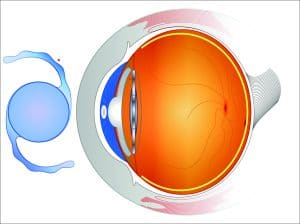
Who Can Benefit from Refractive Lens Exchange?
Most people interested in RLE have started to experience presbyopia (the need for reading glasses), which typically begins in one’s 40s. Your eyes age like the rest of your body, causing the natural eye lens behind the cornea to stiffen and harden, losing its youthful flexibility and therefore its ability to adjust visual focus for near objects. Think of it like an old film camera. For a crisp photograph, you need a clear, dome-shaped piece of glass (cornea) and a lens that focuses light directly (eye lens) onto the film (retina). When the lens can’t zoom properly, you get a blurry image. That is similar to what happens to your near vision as you get older. Your eye’s lens can’t accommodate the change from distant and intermediate objects to things nearby, such as reading a text message or fine print on a menu.
People with presbyopia are often too old for laser vision correction because LASIK focuses on a misshapen cornea, not the lens, but they are too young for cataract surgery. Refractive lens exchange can be ideal for people in this group because RLE is the only refractive eye surgery that can address farsightedness, nearsightedness, astigmatism and presbyopia with premium IOLs. RLE may be particularly beneficial for people with high refractive errors and presbyopia, according to a 2014 study published in the Journal of Eye and Vision.
Refractive lens exchange negates the need for cataract surgery in the future because the eye’s natural lens is completely removed and replaced with an artificial lens designed to last a lifetime. With the right IOL, you can get rid of reading glasses.
Intraocular Lens Implant Options
Mark R. Mandel, MD, uses the ORA (Optiwave Refractive Analysis) System to analyze and refine your intraocular lens implant measurements for the most accurate lens power possible. A monovision technique that improves vision in one eye for distance and the other for near vision can reduce your dependence on reading glasses, and there are toric versions of most IOLs for those with astigmatism.
New artificial lenses, including multifocal, extended-depth-of-field and trifocal IOLs, provide better results than ever, sometimes eliminating the need for readers altogether. While there is a chance you may need glasses for tiny print or additional lighting in dimly lit situations, refractive lens exchange offers significant freedom from corrective eyewear.
Contact Optima Eye in the Bay Area About Refractive Lens Exchange
If you would like to know more about refractive lens exchange, we encourage you to schedule a personal consultation with Bay Area premium cataract surgeon Mark Mandel, MD. Contact Optima Eye by emailing or calling 510-886-3937 today.